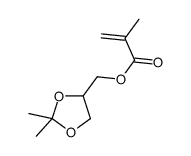(2,2-dimethyl-1,3-dioxolan-4-yl)methyl methacrylate

(2,2-dimethyl-1,3-dioxolan-4-yl)methyl methacrylate structure
|
Common Name | (2,2-dimethyl-1,3-dioxolan-4-yl)methyl methacrylate | ||
|---|---|---|---|---|
| CAS Number | 7098-80-8 | Molecular Weight | 200.23200 | |
| Density | 1.028g/cm3 | Boiling Point | 274.5ºC at 760 mmHg | |
| Molecular Formula | C10H16O4 | Melting Point | N/A | |
| MSDS | USA | Flash Point | 116.2ºC | |
| Symbol |




GHS02, GHS05, GHS07, GHS08 |
Signal Word | Danger | |
|
Characterizing the structure of lipodisq nanoparticles for membrane protein spectroscopic studies.
Biochim. Biophys. Acta 1848(1 Pt B) , 329-33, (2015) Membrane protein spectroscopic studies are challenging due to the difficulty introduced in preparing homogenous and functional hydrophobic proteins incorporated into a lipid bilayer system. Traditional membrane mimics such as micelles or liposomes have proved... |
|
|
Matrix stiffening and β1 integrin drive subtype-specific fibroblast accumulation in lung cancer.
Mol. Cancer Res. 13(1) , 161-73, (2015) The crucial role of tumor-associated fibroblasts (TAF) in cancer progression is now clear in non-small cell lung cancer (NSCLC). However, therapies against TAFs are limited due to a lack of understanding in the subtype-specific mechanisms underlying their acc... |
|
|
Non-aggregating tau phosphorylation by cyclin-dependent kinase 5 contributes to motor neuron degeneration in spinal muscular atrophy.
J. Neurosci. 35(15) , 6038-50, (2015) Mechanisms underlying motor neuron degeneration in spinal muscular atrophy (SMA), the leading inherited cause of infant mortality, remain largely unknown. Many studies have established the importance of hyperphosphorylation of the microtubule-associated prote... |
|
|
Angiotensin II increases matrix metalloproteinase 2 expression in human aortic smooth muscle cells via AT1R and ERK1/2.
Exp. Biol. Med. (Maywood.) 240 , 1564-71, (2015) Increased levels of angiotensin II (Ang II) and activated matrix metalloproteinase 2 (MMP-2) produced by human aortic smooth muscle cells (human ASMCs) have recently been implicated in the pathogenesis of thoracic aortic aneurysm (TAA). Additionally, angioten... |
|
|
MiR-155 modulates the inflammatory phenotype of intestinal myofibroblasts by targeting SOCS1 in ulcerative colitis.
Exp. Mol. Med. 47 , e164, (2015) Abnormal levels of microRNA (miR)-155, which regulate inflammation and immune responses, have been demonstrated in the colonic mucosa of patients with inflammatory bowel diseases (IBD), although its role in disease pathophysiology is unknown. We investigated ... |
|
|
Trophoblast expression dynamics of the tumor suppressor gene gastrokine 2.
Histochem. Cell Biol. 144 , 281-91, (2015) Gastrokines (GKNs) were originally described as stomach-specific tumor suppressor genes. Recently, we identified GKN1 in extravillous trophoblasts (EVT) of human placenta. GKN1 treatment reduced the migration of the trophoblast cell line JEG-3. GKN2 is known ... |
|
|
Loss of Gab1 adaptor protein in hepatocytes aggravates experimental liver fibrosis in mice.
Am. J. Physiol. Gastrointest. Liver Physiol. 308(7) , G613-24, (2015) Grb2-associated binder 1 (Gab1) adaptor protein amplifies signals downstream of a broad range of growth factors/receptor tyrosine kinases. Although these signals are implicated in liver fibrogenesis, the role of Gab1 remains unclear. To elucidate the role of ... |
|
|
Hedgehog signaling indirectly affects tubular cell survival after obstructive kidney injury.
Am. J. Physiol. Renal Physiol. 309 , F770-8, (2015) Hedgehog (Hh) is an evolutionary conserved signaling pathway that has important functions in kidney morphogenesis and adult organ maintenance. Recent work has shown that Hh signaling is reactivated in the kidney after injury and is an important mediator of pr... |
|
|
The calcium-binding protein complex S100A8/A9 has a crucial role in controlling macrophage-mediated renal repair following ischemia/reperfusion.
Kidney Int. 87(1) , 85-94, (2014) Upon ischemia/reperfusion (I/R)-induced injury, several damage-associated molecular patterns are expressed including the calcium-binding protein S100A8/A9 complex. S100A8/A9 can be recognized by Toll-like receptor-4 and its activation is known to deleteriousl... |
|
|
Polymer-Based Reconstruction of the Inferior Vena Cava in Rat: Stem Cells or RGD Peptide?
Tissue Eng. Part A 21 , 1552-64, (2015) As part of a program targeted at developing a resorbable valved tube for replacement of the right ventricular outflow tract, we compared three biopolymers (polyurethane [PU], polyhydroxyalkanoate (the poly(3-hydroxybutyrate-co-3-hydroxyvalerate-co-4-hydroxyva... |